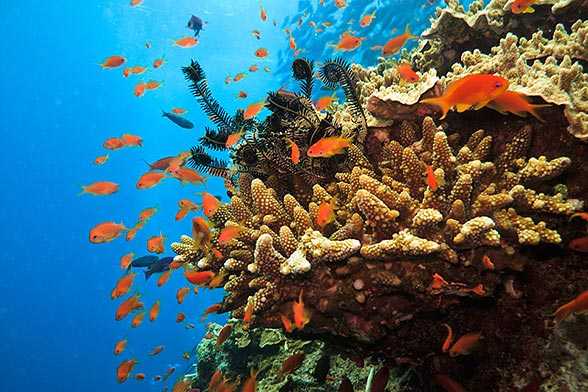The Great Barrier Reef - A World Heritage under Grave Threat

The coral in Australia's Great Barrier Reef is under great pressure from a range of threats influenced by human activity.
With increasing sea temperatures, the corals become susceptible to diseases and bleaching - they stress and release symbiotic algae, and eventually die. This Australian reef has already experienced two mass coral bleaching events in the last 15 years. The latest one, in 2002, was very severe and aerial surveys showed that almost 60% of reefs experienced bleaching of some degree.
On top of this, threats of increasing sea temperature also mean ocean acidification (the oceans absorb more atmospheric CO2) and rising sea levels. Both present a huge risk to the ecosystem, reef communities and other organisms that use calcium to build their skeletons. Climate change is also responsible for tropical cyclones.
The Reef is also under threat because of attacks from the crown-of-thorns starfish, a carnivorous predator that preys on certain types of coral. Again, this threat is ultimately caused, albeit inadvertently, by human impact: as intensive farming efforts and urban run-off allow industrial nutrients to flow into rivers, ending up in the oceans. This polluted water stimulates the increase in population of this predatory starfish species, resulting in the eventual attack against coral reefs. Poor water quality due to excess nutrients also encourages the spread of infectious diseases among corals.
The fishing industry brings an annual profit over $1 billion to Australia, but it has a huge impact on Great Barrier Reef. As a result of “drag effect”, many protected species of sea life in the reed are caught in the nets.
The Great Barrier Reef is a natural paradise with thousands species of fish, sharks and rays, marine turtles and more than 30 species of sea mammals. Unsurprisingly, therefore, the region attracts a lot of tourists. Ironically the very act of people wanting to appreciate and marvel at nature can put it at risk as cruise and sightseeing vessels sometimes add to the problems by spilling oil, creating shipping accidents or simply generating water pollution. All in all, these threats don’t leave much hope of conservation for the Great Barrier Reef; and according to the findings of a report published in Proceedings of the National Academy of Sciences, corals have fallen by nearly 50% in the last 30 years.
We can only hope that, by generating greater awareness of the threats we can control and the risks our actions present, we can go some way to encouraging people to take action and turn the tide on the gradual destruction of one of the world’s most important natural features.